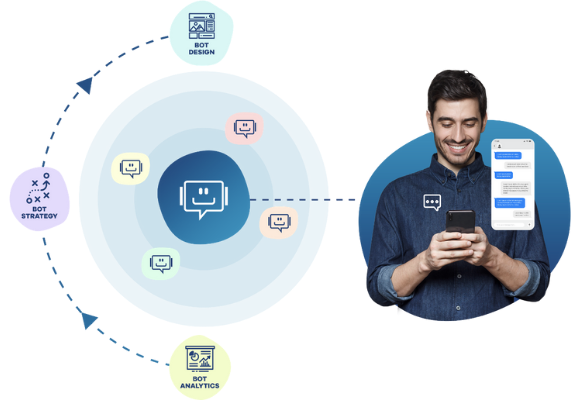8 Steps to a Brilliant Bot Strategy

It’s time to build a Bot Strategy. Are you ready?
Now I’m going to cover how to do that. How to build a bot strategy that suits you, and your business.
This is not trial and error, nor a 1-day workshop delivered by a tech partner to convince you to buy their stuff. This is a 6-8 week process. There are 8 steps.
Step 1 – Understand the strategic backdrop
What are you and your business trying to achieve? Think about these four areas: cost reduction, revenue enhancement, customer experience, and brand. Usually, everyone wants all of these, but go deeper. Will you invest money to improve the customer experience? Or does that investment need to be offset by cost savings? Do you want to differentiate your brand with conversational AI, or just match the competition?
Step 2 – Review your experience, and your competitors’
You need to understand your starting point. Do a review of your current IVR, voice, or chatbot experience. You don’t need to be an expert to do this. Designing conversational AI is not something everyone can do. But most humans know what good conversation is, so while you may not be able to design it, you can review it. Use our Customer Experience Checklist to guide you. Do the same for a couple of your closest competitors.
Step 3 – Get Context
Your bot workforce is part of a wider team. Now you understand what your bots are doing, you need to understand what your human agents are doing too. That means doing side-by-side call listening with agents and reviewing recordings or chat transcripts. Talk to a group of agents about the different requests they get and how they handle them. Review contact center reports to get a feel for the volumes of different tasks, and if you can, the approximate handling time for each of them.
Step 4 – Identify candidates for automation
Bots can’t do everything, so use the information in the previous step to highlight those tasks that occur frequently – at least 5% of total contact volume – and have a simple, repeatable process. These are candidates for automation. They don’t have to be whole calls or chats. They can just be the repeatable part of a longer process: identifying the customer, providing an account balance, or giving order status information.
Step 5 – Build the business case
Identifying direct financial benefits from customer experience and brand enhancements is very hard. There are strong correlations between customer experience and business value, but proving causation is very difficult. Attributing the benefits to a specific experience change is even harder. If you need to demonstrate ROI to get funding for your project, the best approach is to build a business case based on direct financial cost savings. So what’s the value of the tasks your bots perform in comparison to the alternative, which is usually having a human do it? Estimate the number of tasks your bots will perform and multiply by the average handling time for agents to do the same thing and the cost per minute of your agents. Then look at the size and complexity of each task, to get a feel for the cost. You don’t need decimal points here. T-shirt size is OK: small, medium, large.
Step 6 – Prioritize and plan
Some things that seem appealing early on, look less so when you’ve checked the value and cost. You can drop them. But you should still have a bunch of things that are worth doing. Don’t try and do it all in one go. First, identify the quick wins: decent volume, no IT dependencies, small t-shirt size. Next up, phase 1 should include bigger tasks, still with good volume, and manageable IT requirements… as in, the API is available now or it’s already on the IT roadmap. Phase 1 should also include foundational elements: things that you’ll need to build out your vision. Phase 2 and beyond includes everything else: tasks that will need new APIs built, or that rely on foundational elements from Phase 1. Make sure each phase has demonstrable ROI: the costs for delivering that phase need to be outweighed by the benefits calculated in the business case step.
Step 7 – Articulate the vision
Don’t skip this part! You’re deep into the weeds, and you know this project is worthwhile. But other stakeholders don’t have that detail, nor the time to consume it. You need to build a compelling story around the outcomes of the first 6 steps. There are many different approaches, but a simple framework to use is the hero’s journey:
Set the scene: the strategic backdrop, the review you did of your current experience.
Show the challenge and opportunity: what your competitors have (from your review), what you could have (candidates for automation).
Define the objective of the quest: It really helps if you can bring the vision to life with recorded audio samples or chatbot storyboards… but you’ll need a conversation designer for that. If you don’t have access to one, take audio or screen recordings of examples you found in your competitor review and use those.
Then show the path to get there: your plan, and the ROI for each phase.
Step 8 – Deliver it!
Got buy-in? Got budget? Great, let’s do this! But remember this isn’t just a tech project. You’re building a bot workforce here, so you need to put a bot management system in place. Check out our Bot Management System e-book to get a feel for what that entails.
Phew. That’s a lot, right? And that’s why you can’t leave it to your tech vendor, nor do this in a couple of meetings or whiteboard sessions. This process really works, but you’ve got to put the time in.
You can do this, but this blog isn’t enough. Nor is reading a couple more blog articles. If it was, you’d have done it before, wouldn’t you? In my next blog article, I’ll be showing you some options that will help you get this done.
In the meantime, let me know what you think of this approach. Have you done any of this already?
Did it work for you? What problems did you encounter?

Watch our on-demand webinar “Making Sense of Conversational AI.” Gain a new perspective on conversational AI, how it fits into your customer service strategy, and how you can get the most out of it.
Subscribe to our weekly AI Insights





